|
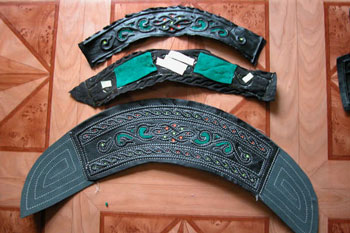
They showed how they added the coloured cloth behind the cut-outs.
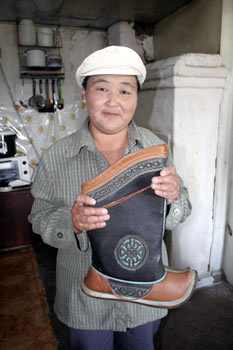
Shura
said she knew how to make boots by hand like this one in the
old traditional way and in fact, had some old-style black leather
available. Boot fanciers can tell the age of the boot from the
leather, the color and the style.
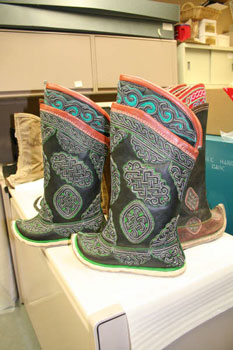 I asked
Shura to make us a pair, repeating several times that they must
be completely hand made, be devoid of any plastic, and done in
an old traditional style - with as many ornaments as possible.
A couple of months later the boots arrived in Toronto and you
can see them today on display. These only have 48 ornaments,
24 on each boot. There just isn't room for 64 ornaments on women's
boots. I asked
Shura to make us a pair, repeating several times that they must
be completely hand made, be devoid of any plastic, and done in
an old traditional style - with as many ornaments as possible.
A couple of months later the boots arrived in Toronto and you
can see them today on display. These only have 48 ornaments,
24 on each boot. There just isn't room for 64 ornaments on women's
boots.
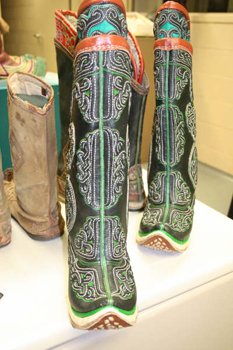 Langaa
and her husband make 10 to 15 pairs of boots a month by machine.
She learned her craft in a boot-making school in Ulaan Baatar
and then taught her husband. She has been making boots since
1976. Langaa
and her husband make 10 to 15 pairs of boots a month by machine.
She learned her craft in a boot-making school in Ulaan Baatar
and then taught her husband. She has been making boots since
1976.
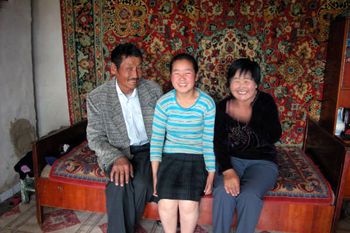
Their daughter expects to be a boot maker too, though all of
their three children know how to make boots. All wore Mongolian-style
boots when they were small, but none of the younger generation
wants to wear them now, they said.
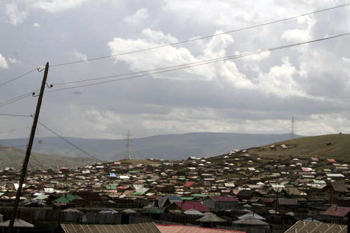
They live in a community of gers, circular white tents, and small
cottages in the suburbs of Ulaan Baatar and only make about $300
a month.
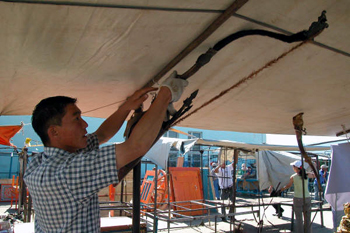
We also found old boots in Ulan Baatar's wonderful flea market.
The Narantuul market sells everything from old Mongolian bows
to saddles, solar panels, clothes, fancy chandeliers and food.
Unfortunately, it's full of pickpockets so I've only taken a
camera there once.
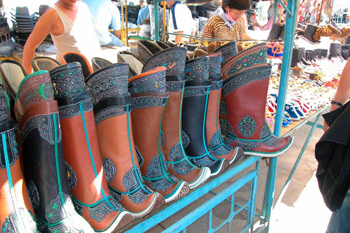
This flea market also sells new boots, like the kind Shura makes.
This is the current style. They sell for about $75 a pair. We
also found a merchant here who had a set of old boot-making tools
so these too are now in the Museum.
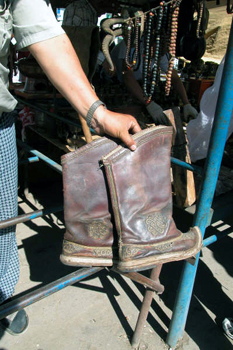 I found these
old boots in the antiques section of the market. There were about
six dealers and all of them claimed their boots were 100 years
old or belonged to a famous person. I almost bought these boots
for about $170 but I left the room to check out other merchants.
When I returned to buy them, the seller said a neighbouring merchant
told her not to sell them so cheaply and the price had increased
to $220, a difference of $50. I was so angry I refused to buy
them. I found these
old boots in the antiques section of the market. There were about
six dealers and all of them claimed their boots were 100 years
old or belonged to a famous person. I almost bought these boots
for about $170 but I left the room to check out other merchants.
When I returned to buy them, the seller said a neighbouring merchant
told her not to sell them so cheaply and the price had increased
to $220, a difference of $50. I was so angry I refused to buy
them.
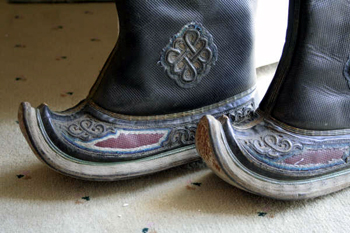
The following year I went back to the same dealer and found the
same boots. The dealer remembered me, and without question brought
them down from the shelf, dusted them off and quoted $170. She
was back to her first asking price. I don't think there are many
buyers of old boots in Mongolia. These boots are on display today
too.
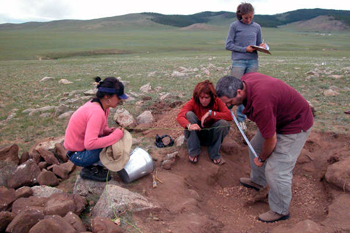
We found other boots in the countryside. My travelling companion
Caroline Walker wanted to visit an archaeological dig led by
Francis Allard of the University of Pennsylvania. It was about
150 km west of Ulaan Baatar in the middle of nowhere. You can
see a group of gers in the background - at least two kilometres
away - the closest other humans to us. The students were working
on a 2000-year-old Xiongnu chieftain's grave and an older bronze
age site with buried horse heads all pointing towards the rising
sun.
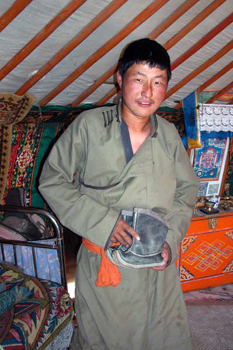 On the way there,
our guide said we could stop at any group of gers we wanted where
we could ask about old boots. So we knocked at the gate of one
group and in the Mongolian way, our guide asked the family to
tie up its dog. A young man invited us in. He and his father
worked on the roads and they still had the boots worn by the
son when he was a child. On the way there,
our guide said we could stop at any group of gers we wanted where
we could ask about old boots. So we knocked at the gate of one
group and in the Mongolian way, our guide asked the family to
tie up its dog. A young man invited us in. He and his father
worked on the roads and they still had the boots worn by the
son when he was a child.
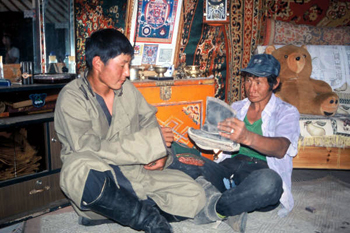
The boots were not fancy, but the Museum here likes to get a
wide range of footwear for research and educational purposes
so I bought them. And then Munkhuum and his son Munkhuugiin posed
for a couple of pictures. The father wanted one taken of himself
handing over the boots to the young man….
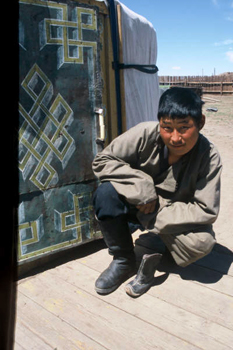 These boots
are also on display today. Snuff also symbolizes the passing
on of the family heritage, an acknowledgment of manhood. I felt
it was a privilege to record this rite of passage. These boots
are also on display today. Snuff also symbolizes the passing
on of the family heritage, an acknowledgment of manhood. I felt
it was a privilege to record this rite of passage.
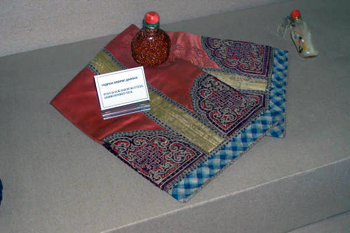
Snuff bottles and snuff envelopes are an art form in Mongolia.
This wonderful one is in the Museum in Ulaan Baatar. Of course
Munkhuugiin's is not as fancy.
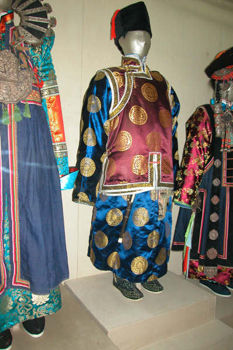 I also
saw these ornate boots in the Museum in Mongolia. My Mongolian
friends in Toronto think are Buryiat. I also
saw these ornate boots in the Museum in Mongolia. My Mongolian
friends in Toronto think are Buryiat.
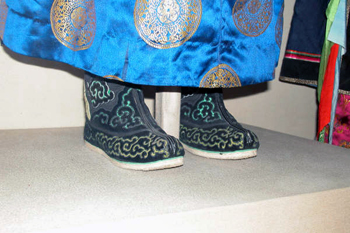
But I couldn't find any more information about them so I'll ask
about them this summer.
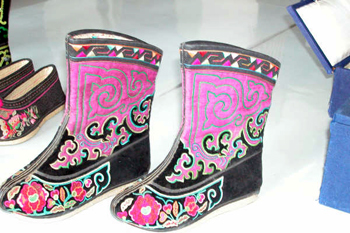
These are from the Museum in Hohhot in China's Inner Mongolia,
are obviously women's boots and don't seem to be known in Outer
Mongolia. They also might be southern Buryiat.
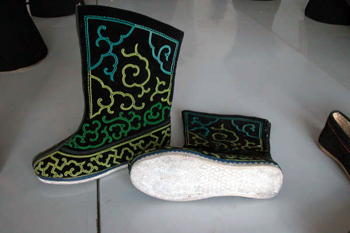
The soles of both of these were quilted by hand like many old
traditional Chinese shoes.
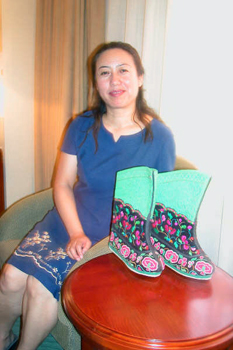 We
also went to the Museum and antique market in Hohhot in Inner
Mongolia in China. But the only pair of traditional ethnic shoes
I found for sale were these, made by a sister of a retired staff
member of the Museum. She said these were made in the 1960s in
Xilinhot, about 600 kilometres northeast of Hohhot, Inner Mongolia.
I brought them back of course. Mrs Bata said she would have preferred
a more muted, a more traditional colour but we had no choice. We
also went to the Museum and antique market in Hohhot in Inner
Mongolia in China. But the only pair of traditional ethnic shoes
I found for sale were these, made by a sister of a retired staff
member of the Museum. She said these were made in the 1960s in
Xilinhot, about 600 kilometres northeast of Hohhot, Inner Mongolia.
I brought them back of course. Mrs Bata said she would have preferred
a more muted, a more traditional colour but we had no choice.
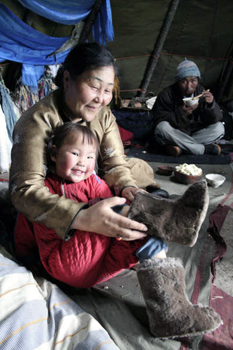
I've
brought other interesting boots from Mongolia but they are not
on display today.
Collecting in Mongolia is wonderful. I bought these reindeer
fur boots from a Tsaatan woman near Lake Khosovol who said she
was a shaman. She had 15 reindeer and she had made these boots
herself.
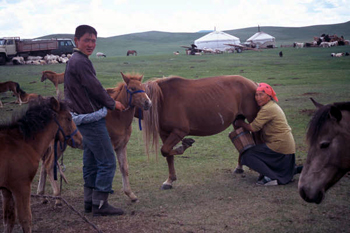
We were at another set of gers for several hours watching the
pastoralists milking the mares and sheering the sheep and goats.
They believe mares' milk is especially healthy and along with
cheese, yogurt and bread, it seems to be all they eat in the
summer unless they slaughter an animal.
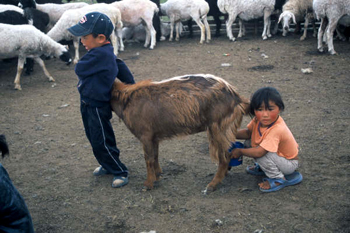
The children played nearby and didn't have far to go for a snack.
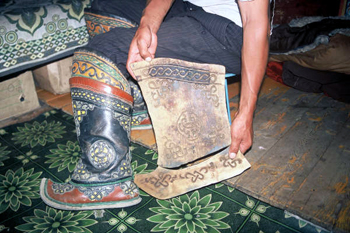
They sold us this wooden mould they used for making the decorations
on the boots and promptly started to carve another one freehand.
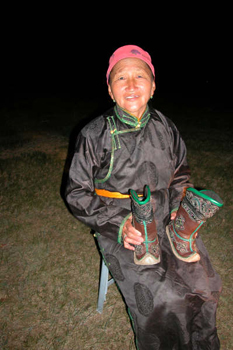 That evening the matriarch of the
family, all dressed up, brought a pair of her grandson's boots
to our camp. Of course I bought them. She had made them herself
and they were so cute. That evening the matriarch of the
family, all dressed up, brought a pair of her grandson's boots
to our camp. Of course I bought them. She had made them herself
and they were so cute.
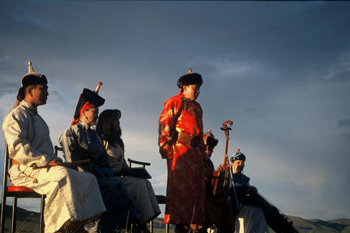
We even bought footwear from a famous throat singer Tumurbaatar
Khasbaatar, who performed one night at our ger camp. That's him
in red standing up. Throat singing is one of the arts in this
country and our guide knew he was a collector so she asked him.
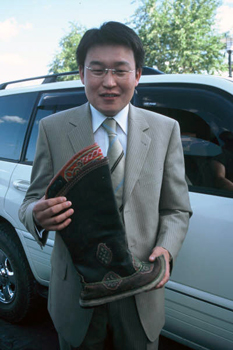 He
delivered this pair of boots wearing a western suit to our hotel
on his way to a wedding. He is also a business man living in
Ulaan Baatar. He
delivered this pair of boots wearing a western suit to our hotel
on his way to a wedding. He is also a business man living in
Ulaan Baatar.
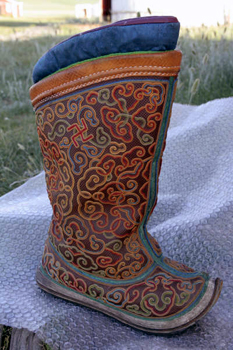
And
finally, almost on my last day in Mongolia, I managed to acquire
a pair of boots worn by the consort of the last ruler of Mongolia
who died in 1925. I bought them in an antique store in Ulaan
Baatar and they look much like the ceremonial boot in the Museum
in Ulaan Baatar. They are now upstairs in the Treasures of the
Bata Shoe Museum.
|